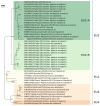First Detection and Molecular Characterization of Usutu Virus in Culex pipiens Mosquitoes Collected in Romania
- PMID: 36985256
- PMCID: PMC10054730
- DOI: 10.3390/microorganisms11030684
First Detection and Molecular Characterization of Usutu Virus in Culex pipiens Mosquitoes Collected in Romania
Abstract
Usutu virus (USUV) is an emergent arbovirus in Europe causing mortality in bird populations. Similar to West Nile virus (WNV), USUV is maintained in sylvatic cycles between mosquito vectors and bird reservoirs. Spillover events may result in human neurological infection cases. Apart from indirect evidence provided by a recent serological study in wild birds, the circulation of USUV in Romania was not assessed. We aimed to detect and molecular characterize USUV circulating in mosquito vectors collected in South-Eastern Romania-a well-known WNV endemic region-during four transmission seasons. Mosquitoes were collected from Bucharest metropolitan area and Danube Delta, pooled, and screened by real-time RT-PCR for USUV. Partial genomic sequences were obtained and used for phylogeny. USUV was detected in Culex pipiens s.l. female mosquitoes collected in Bucharest, in 2019. The virus belonged to Europe 2 lineage, sub-lineage EU2-A. Phylogenetic analysis revealed high similarity with isolates infecting mosquito vectors, birds, and humans in Europe starting with 2009, all sharing common origin in Northern Italy. To our knowledge, this is the first study characterizing a strain of USUV circulating in Romania.
Keywords: BG-Sentinel trap; CDC gravid trap; CDC light trap; Culex pipiens mosquitoes; Europe 2 lineage; Romania; Usutu virus; phylogenetic analysis.
Conflict of interest statement
The authors declare no conflict of interest.
Figures



References
-
- Williams M.C., Simpson D.I.H., Haddow A.J., Knight E.M. The Isolation of West Nile Virus from Man and of Usutu Virus from the Bird-Biting Mosquito Mansonia Aurites(Theobald) in the Entebbe Area of Uganda. Ann. Trop. Med. Parasitol. 1964;58:367–374. doi: 10.1080/00034983.1964.11686258. - DOI - PubMed
Grants and funding
LinkOut - more resources
Full Text Sources

